Thinking back, I really wish I would have been given the opportunity to hammock camp as a kid. My family did a lot of tent camping when I was growing up, which was great, don’t get me wrong, but camping in a hammock would have been so much cooler. Now that I am an adult, I decided not to let the age of our kids limit what we could do. I started teaching my kids to sleep in hammocks when they were quite small. I don’t see a legitimate reason that there has to be an age limit on hammock camping. My advice is to start them young and instill the rules of safety early on.
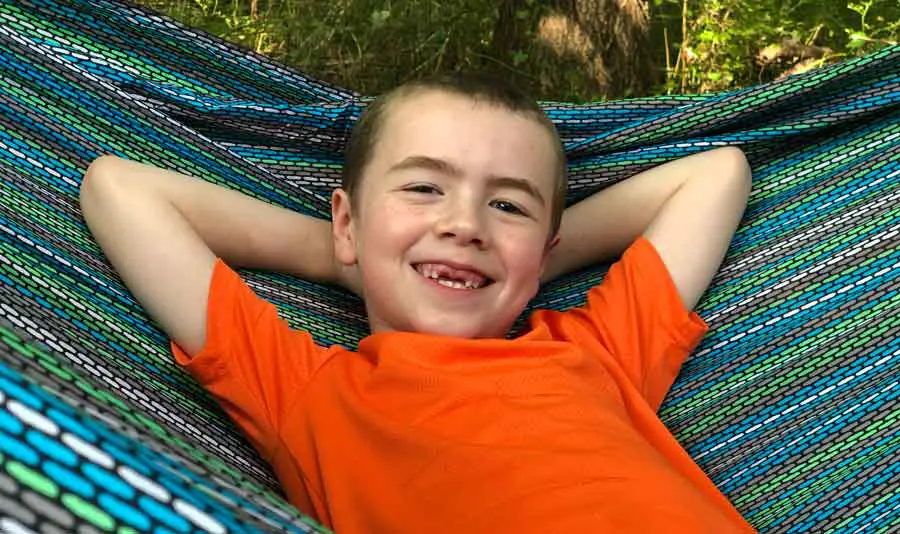
If done right, camping with kids can be a fun and memorable time for your family. The key being, if done right. Just like any camping trip, things can happen. I guess if I’m being honest, and thinking as a dad, I know anything and everything can possibly happen. Realistically, some of those things are most definitely going to happen. This article is intended to be a starter guide for parents who are attempting hammock camping for the first time with kids.
First, let me give you a little bit of background on me and my boys. Ya know, so I have some street cred. My two boys are very active in Cub Scouts. If you are a scout parent then you also know that it means that I, myself, am also very active in Cub Scouts. At the writing of this article, my oldest has been in scouting for four years and my youngest for two years. Every summer we are out camping at least every other week. Sometimes because of various scouting events, but also just because we want to.
I bought the boys their first hammocks shortly after I had gotten my own. My practice setups in the backyard turned into siesta time, and the boys often joined me. They loved the hammock so much that they begged for their own. My youngest boy started sleeping in a hammock at age 5 and we’ve never looked back.
So here’s a quick run-down of the tips and tricks I learned along the way. We will go into much more detail on each one, so don’t worry.
- Teach safety first
- Get them used to the hammock
- Hang low to the ground
- Have them help
- Know your kid
- Snug as a bug
- Camp in the yard
- Get close
- Going potty
- Let there be light
- Wear them out
- Tuck them in
- Don’t go to bed
- Be a hammock ninja
- Celebrate
- Teach conservation
1. Teach safety first
If you’ve been around here any length of time at all, you know safety is my thing. It is for this reason that it is number one on a lot of my lists. Safety is an even bigger deal when you are talking about kids. Camping safety is the first thing I taught my boys about the woods. It should be for your child as well. The number one rule is: Don’t leave camp by yourself. Ever. It’s easy to get lost, so stay close. Depending on the age of your child, sometimes it helps to give them well-defined boundaries.
Don’t go past the big tree over there.
See this stick/branch? Please don’t go past it.
It’s important to let your kids explore your campsite and the area around it. The less curiosity, the better. The major concern when hammock camping with young children is that they will get out of the hammock in the middle of the night and go wandering around in the dark alone. While this can and has happened to families tent camping, I think people feel more secure when they are all sleeping in a shared space. However, hammock camping with your kids can be safe if you teach them the safety rules from the very beginning.
The number one rule I taught my kids about hammock camping was:
Once you are in your hammock for the night, you stay in your hammock. You don’t get out without permission. When I am there with you, is when you can get out.
It terrifies me to think of a tiny kid getting lost in the woods in the middle of the night. I feel I’m probably not alone in having that fear.
It’s also essential to set up general camp rules for your kids to follow. These are basic rules, but still important for them to know. Teaching fire safety is a must. Make rules about no running around the campfire, don’t sit anything to close to the fire, the fire will burn you, watch for tripping hazards etc.
Set up boundaries and talk about how it will keep them safe to stay within those limits. Making the entire campsite a “walking only” area is sometimes useful or necessary for safety. If you have tarps on your hammocks, you will have guylines that are trip hazards. After you’ve set up and there is still daylight, make sure you walk around your campsite and show your kids exactly where the trip hazards are located.
It’s always good to go back to basics when we talk about fire safety. “Remember Only You Can Prevent Forest Fires.” Smokey the Bear has some great resources to teach kids about fire safety.
Being in total darkness can be really scary for kids. Some just aren’t comfortable with it. My boys have never had a problem with being afraid of the dark, but I made absolutely sure they were ok with it before we ever left home. Fears of the dark can be intense for some kids so it’s best to know how your child will react to being in a hammock all alone in the dark all night. Practice at home and if your child is having trouble, I would recommend putting a pin in it and trying again when they are a little older.
2. Get kids used to the hammock
Don’t let the first time you go hammock camping with your kids be the first time they are ever in the hammock. Like I mentioned above, the darkness and being all alone can be a big issue for some kids. Throwing them in the hammock after dark, zipping them up, and saying goodnight could definitely make matters worse.

Set up the hammock at home and let them safely play in it and explore it. You want to make as many pleasant and positive associations with the hammock as you possibly can. Lay down in the hammock with your child and maybe take a summer afternoon nap. I didn’t do it intentionally, and the thought of my youngest hammock camping hadn’t crossed my mind, but this is how my boys were acclimated. They just napped with me in the backyard. Once they found out that the hammock could be used for more than just backyard naps, they eventually began begging for one of their own.
I definitely recommend low-pressure naps to have your kids practice feeling safe and secure in the hammock. Definitely, don’t mess around and let them accidentally fall out or flip over in it. It’s scary to fall from a hammock even for an adult so it’s probably worse for a kid. Only positive and safe things during their time in the hammock. This will pay off later.
3. Hang low to the ground
The first time you hang the hammock for your kid, don’t hang it any higher than about 6 inches off the ground. This will keep any fears of heights at bay and won’t be as intimidating. If they do accidentally fall out, the fall won’t be nearly as scary.
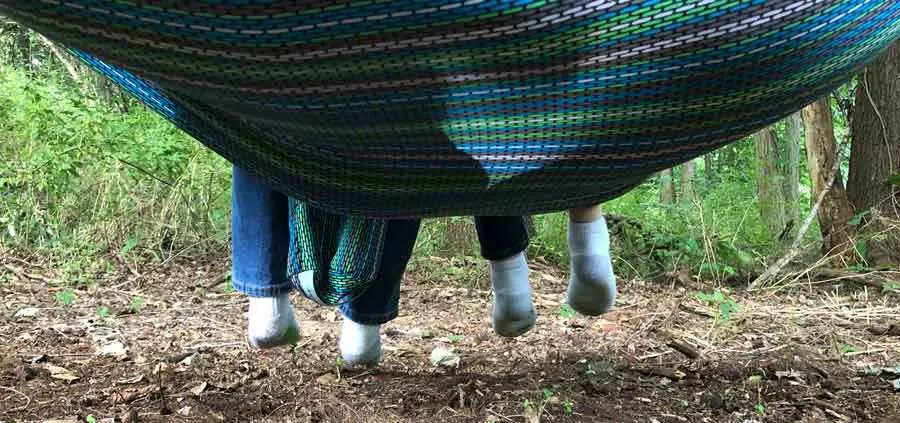
For my boys, I hang their hammocks at the height of their rear-ends. This way they don’t have to jump up to get into it and can easily get out of it on their own. Ultimately you just want your kid to feel comfortable and safe getting in and out on his or her own. You definitely don’t want them climbing up into it or hopping out of it. This is how accidents can happen. The last thing you want on a camping trip is to end it early because someone got hurt.
4. Have kids help
You want your kids to get to know the hammock inside and out. You want them to feel safe and in control while in and around it. The best thing to do is to teach them how to set up their own hammock – or at least help and watch while you do it for them if they are too young.
I’ve always found that having your kids be a part of things makes them more excited and engaged. Hammock camping is no exception. Like I previously mentioned, you want your hammock camping experience to be positive. While they may not be able to set up entirely on their own, there are plenty of things that they can help out with.
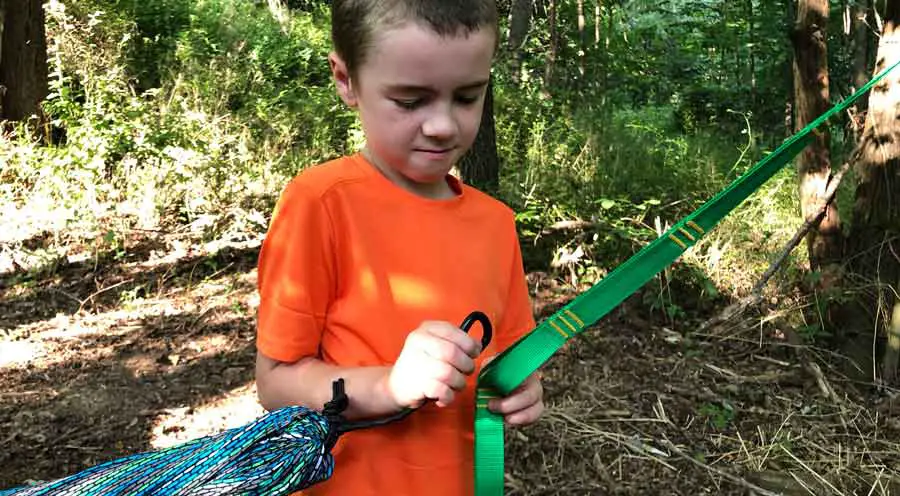
Teach them about the trees and how to choose the right ones. Have them run around the tree and help with the straps. Let them clip their hammock to the straps. If they are able, let them help hammer in the tie-outs for the tarp. Kids are like sponges and love to help out. They won’t ever forget setting up camp and enjoying that time together. It’s what good family memories are made of.
5. Know your kid
As a parent, you know your child better than anyone. You know what your child is and is not capable of doing. So sometimes no matter how bad you want to go hammock camping with your kids, it’s not always the best idea. I realize I’m probably not telling you anything you don’t already know.
If your child is scared of the dark or doesn’t like being alone in a room by themselves, then it might be too soon to try hammock camping. You don’t want your child to develop a fear of camping by ignoring his fear of the dark or being alone. Don’t compound that fear and force him to sleep in a hammock in the dark on his own. That would be terrifying for him. The bottom line here is to respect your child’s fears and desires.
On the other hand, if you have a child that is independent and has a strong desire to sleep in a hammock all night, then try it out. I still recommend a trial run close to home at first just in case things are too much for them. Both of my boys were always gung-ho about sleeping in a hammock. They didn’t have any fear of it. As I mentioned, my youngest boy was 5 the first time he hammock camped and he did great. He loved every second of it and wanted to keep sleeping his hammock. In fact, after a couple of camping trips, he asked if we could set it up in his bedroom. My oldest boy was 7 his first time and it was the same for him. He loved every minute of it. He asked if he could give his tent to someone else who needed it because he wouldn’t ever use it again. My kids have always been content to sleep alone in their hammocks, but not all kids feel the same way. Just do some trial runs and find out what is going to be best for your child.
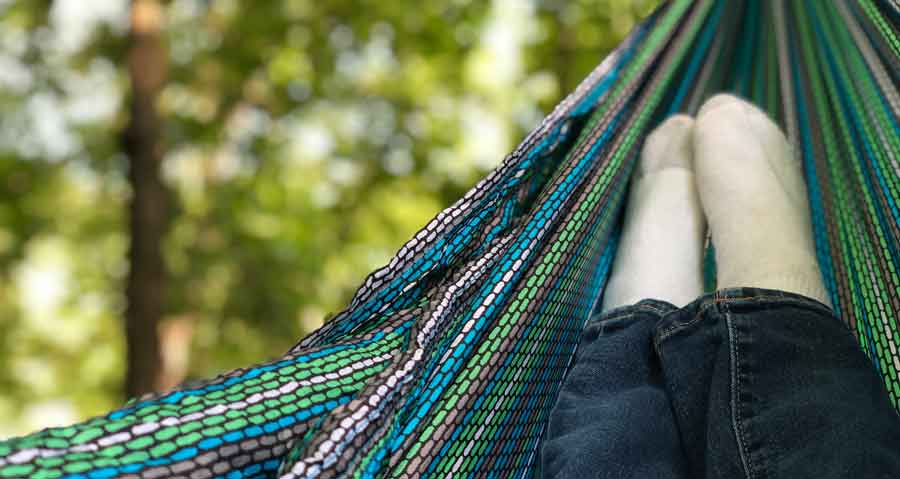
A note about the young children I call the “fearless wanderers.” We all know one or have one of our own. I’m talking about the kids that seem to be absolutely fearless in everything they do. You know’em. The kids you find climbing to the top of every tree, getting into things even when they have been asked not to, doing flying Super-Mans off of countertops, attempting to hang on to the ceiling fan for a little joy-ride, breaking the rules because…well…they can.
If you have a kid that throws caution to the wind and is prone to wandering about on his or her own, I would highly reconsider hammock camping. Rules are incredibly important to follow to keep everyone safe. So if you have a little rule-breaker on your hands, it would probably be wise to wait until they are a little older.
Please don’t take that as me being judgemental about that either. I have a nephew who fits this description to a T and he is one of my favorite people in the world. He is a blast and always up for anything. He’s an adventurous little one and lives life with reckless abandon. I literally can’t wait to see what he becomes when he gets older. However, for his own safety, I can’t take him hammock camping until he’s reliable at following rules.
6. Snug as a bug
Making sure your kid stays warm in the hammocks through the night is crucial. This all goes back to keeping everything about the hammock camping experience positive. Waking up cold in the night isn’t fun for anyone. Having the proper equipment and insulation system will prevent cold nights and keep your kiddo comfy.
Prepare by looking at the forecast and pack accordingly. If you aren’t aware, you need proper insulation if it is 70 degrees F or under. Colder weather is going to require more insulation such as an underquilt, whereas on warmer nights you can keep warm with just a sleeping bag. At first, you may pack too much and it will be overkill, but it’s better to have more than you need especially when you have little ones with you.
If you are new to hammock camping and aren’t quite sure what you will need, check out the article I wrote on hammock camping essentials.
7. Camp in the yard
Setting up practice and trial runs will pay off big time. The first time the kids and I camped in our hammocks together was in the backyard of our house. I didn’t just want to throw them into a potentially scary situation by taking them out to the woods and just hoping everything would be okay. I had to test the waters so to speak, and that’s what I urge you to do as well.
If you don’t have trees in your backyard, then find a somewhere close or a family member’s house that has trees. The goal is to stay close enough to home or familiar place that you can retreat to if you get out there and your kid isn’t enjoying the experience.
Whatever you do, don’t force them to make it through the night if they are scared or uncomfortable. You don’t want to risk the chance of the experience being so negative that they never want to go again. Build their trust in you. Let them know that if at any time they feel unsafe that you will pack up and leave.
Also, always be in a hammock nearby. You’re probably like, “Duh, Chris.” It just has to be said. It’s never a good idea to let kids hammock camp on their own. On the flip side, some of our greatest conversations have been just laying in our hammocks and talking about our day or the anticipation of the events happening the next day. It’s family time that you definitely don’t want to miss out on. Trust me.
8. Get close
This ties into the last section. Try to hang your hammock as close as possible to your kids. Find the right grouping of trees that will allow all of you to hang close together.
If your setups are spread out too far apart you won’t be able to hear if your kids are up or rustling around in their hammock. You don’t want your child to get out of their hammock without you knowing. I’m going to be honest, just typing that last sentence gave me heart palpitations. If you’re still new to hammock camping, or even camping in general, you always want to stay close to your little ones and help them understand the importance of staying close to you. This goes back to teaching safety to your kids.
There are various ways that you can camp close together. Here are some ideas:
If you find two large trees, you can actually hang off the same tree and have your straps pointed out to the sides. This can give you just enough space between your hammocks. You might bump each other but still be able to have a good night. Another option is to get spacer bars that you hang side by side and they push your hammocks apart
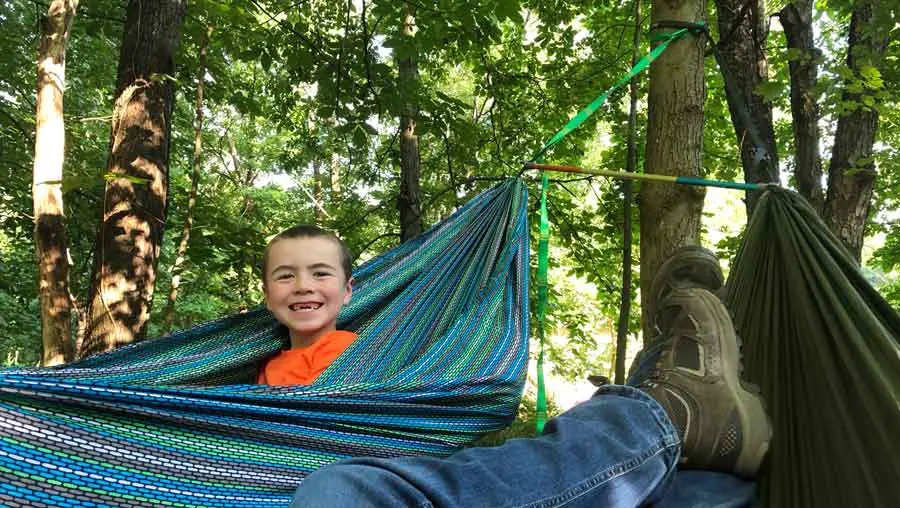
You can also stack your hammocks. It’s pretty much hammock bunk beds.
Disclaimer: There’s controversy around this topic of stacking hammocks and safety so do a lot of research beforehand and do it at your own risk. Obviously, with the height, there are risks involved. My boys and I have been hammock camping together for some time, so I feel comfortable safely stacking our hammocks. I would not recommend this as a first-timer.
Anyway, back to your regularly scheduled Chris… I usually have my oldest on top and lift him up into his hammock for the night. I keep my youngest closer to the ground just in case he tries to get out on his own – he’s not supposed to, but he’s a kid and kids occasionally break the rules. This comes back to knowing your kids. I have a risk-taker (youngest son) and one that won’t take risks at all (oldest son). As I often do, you can also sleep on the bottom of the stack and have the kids above you.
The primary goal is to be close enough in the case that something happens in the night. For example, “Dad! Daaad! I have to go potty!”
9. Going potty
Don’t get in the hammock for the night until everyone has gone to the bathroom. You will inevitably be getting up in the night because someone has to pee. Depending on the amount of water consumed, could be multiple times. Avoid frustrations by getting them to go potty right before they get in their hammocks for the night.
I’m not going to lie, I get super frustrated when I get all comfy in my hammock start to slowly drift into a blissful sleep then, “Dad. Dad. DAAAAD! I have to go potty.” You know how it goes. They, of course, didn’t have to go 10 minutes ago when I asked them before I put them in their hammocks. Sigh…It’s a struggle. So this isn’t a mandatory thing, but it will help you avoid some frustrating moments.
10. Let there be light
This is a pretty big one, depending on your child. The darkness in a hammock can be scary even for kids who aren’t afraid of the dark in other circumstances. Even though my boys don’t have a fear of the dark I want them to always feel safe. Even as an adult, I’ll be the first to admit that it’s a little unnerving to hear sticks breaking around you during the night and not knowing what is lurking outside just feet from you. We adults can surmise that it’s probably a woodland creature and all is good with the world, but kids have wild imaginations and could think Big Foot or a monster is out looking for them.
At home, my kids have a set bedtime and it’s lights out at that time. When they were tiny tots and tent camping I would have a little lamp on at a low setting as a night light. When they moved to their hammocks, I needed to figure out a way to make them feel safe. When I put them in bed, I don’t tell them lights out. I tuck them in and tell them goodnight and I’ll be over here if you need me. I always make sure each child has a headlamp and a flashlight when camping, so one is on their head (hard to lose) and the other in their hand (you will likely be replacing flashlights since they will vanish without a trace).
One thing I started doing that the kids love and they now expect every time is I give them each a large glow stick. Glow sticks are great as night lights and keep them feeling safe. I have also found that they tend to go to sleep faster when they have glow sticks instead of flashlights as a night light. They turn off their flashlights and play with their lightsabers…I mean glow sticks for a few minutes then fall asleep.
Amazon carries packs of glow sticks that will last you quite a while. Personally, I prefer to get green or yellow because they shine the brightest. I would avoid blue and pink. They don’t shine as bright and don’t usually last through the night. The green and yellow glow sticks are also bright enough to light your path while walking if you need it. So it’s perfect for kids in a hammock. I would even say it’s an essential camping item for us.
11. Wear them out!
I know this is kind of seems like common sense, but I’m not kidding about it. The boys and I have had the most successful nights when the boys are tired. When the kids are super tired, they don’t really have time to think about if they are scared or not liking being by themselves. If they are tired, they will fall right to sleep. I know when my boys are really tired they pass out within just a few minutes and they don’t wake up in the night at all.
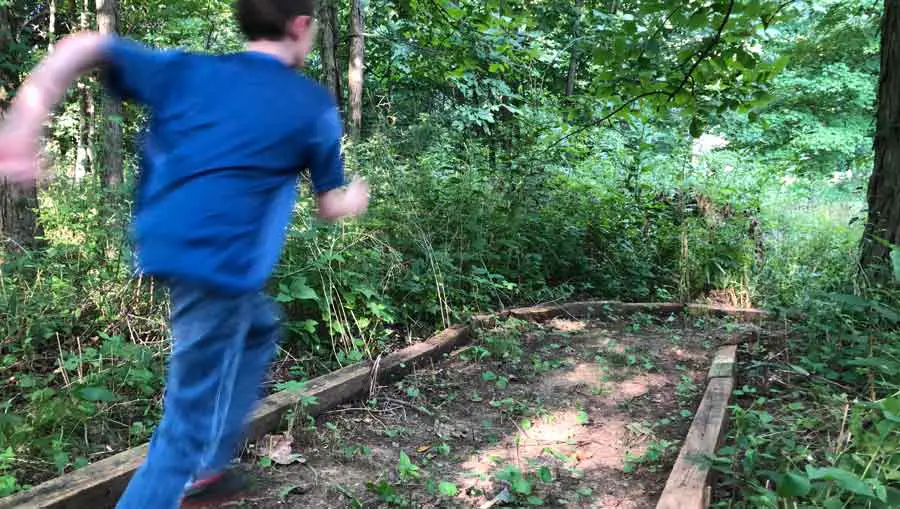
Along these same lines, I don’t really have bedtimes when we are camping. As long as your kids are being good sitting around the fire or wherever, it’s an excellent time to have some family bonding. We like to stargaze until we are tired and then we head off to bed. It’s always a great experience to see the reactions of your kids when they see a shooting star. There are some great apps for your phone to show the constellations. I use the app called Sky Guide Pro. The app sends notifications when the International Space Station is going to be overhead and when you can see other astrological events in the sky. It’s really cool.
12. Tuck them in
This is honestly when I have some of the best conversations with my kids while I am tucking them in their hammocks. I help them get all situated and comfy, so they are good to go to bed. We like to talk about our day and we discuss what their favorite things were about the day. If it’s our first night, we also talk about all the fun we are going to have the next day. It gets them excited to fall asleep and get started on our adventures the following morning.
This is excellent bonding time, but it’s also taking time to keep their minds off of something that might be new and strange – and maybe even possibly scary. My youngest started sleeping in a hammock when he was 5. It was a little scary for him, but he wanted to be like daddy and sleep in a hammock like a big boy. I made sure that I took the time at night to talk to him about how cool it was that he was sleeping in a hammock while everyone else around us in the campground was in tents. I would keep telling him how awesome he was and how much he would end up liking hammock camping. It always worked really well, and he was so proud that he could sleep all by himself at 5 years old.
13. Don’t go to bed
When it is time to tuck those little humans in their hammock, don’t immediately go running to yours. This is a handy tip. I’m ashamed to admit that this took me four or five camping trips before this dawned on me. I am typically worn out and past my limits from trying wear out my boys for bed, but I still try to hold off on going to sleep right away.
My kids will always call for me or want to get up at least once within 10 minutes of being in their hammock. “Dad, I have to go to the bathroom.” “Dad, I forgot my water bottle in my pack.” “Dad, I have something weird in my sock.” I’ve decided not to fight this inevitable truth. For one it’s futile, and two I’ve found some joy in it. Now I stay up at least 15 minutes after I put them to bed and enjoy some alone time until I’m summoned. I’ve avoided a lot of unintentional grumpiness and frustration this way. I’ll be honest, those 15 minutes of just being in the quiet of nature, listening to the sounds of the night, and watching the fire die down are some of the most relaxing moments you can have in a day. At least for me, anyway.
14. Be a ‘Hammock Ninja’
You need to become a Hammock Ninja. What is a Hammock Ninja?! It’s an art, really. It is the ability to quickly and flawlessly get out of your hammock at a moment’s notice. It does take practice so I recommend you take the time especially if you have young kids. You are definitely going to need this skill.
When I first started hammock camping with my boys, I practiced getting out of my hammock in the dark as fast as I could. I’m not kidding. I really got in and practiced getting out quickly. I have a system where I hang my headlamp on my ridgeline for easy access and keep a penlight in my pocket when I sleep. If they need me in the night, I just reach up and turn on the headlamp and jump out and slip on my shoes. I use the penlight to light my path and to deal with anything unexpected when I get to my kids.
If you are camping with kids, it’s going to happen. Everyone is sound asleep and then you hear a crying kid or a kid yelling, “I HAVE TO PEEEE!!!” This is where your training comes in. Even though my boys have grown up a little, I still occasionally I still hear a soft call for me in the middle of the night. Also, even though I know they are not scared, I still want them to know I am right there at all times. Yeah! Hammock Ninja!
Just practice, and you will move up from your yellow belt hammocker to a black belt hammock ninja in no time.
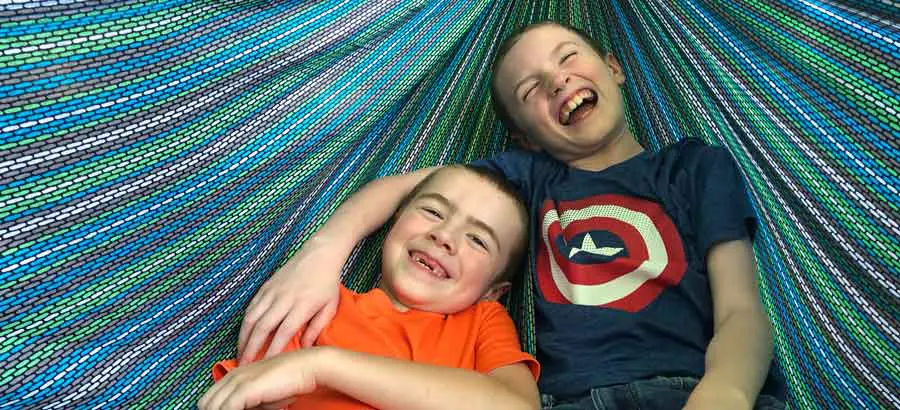
15. Celebrate
Celebrate successful nights with your kids. When my little guys were younger, we would have a morning celebration for how they slept all night in their hammocks. I tease them and say, “I would have slept well in my hammock, but I kept waking up thinking there was a bear outside, but it was only you snoring.” They always laugh, and we talk about how we all slept like babies. You have to celebrate the wins. It makes their camping experience that much better. It also gives them pride and confidence that they can sleep outside by themselves in their very own hammock. They really do snore, by the way. Don’t tell them I told you.
16. Teach Conservation
It’s important to teach your kids about the woods and how to be conservation-minded. I take every opportunity to help my kids in understanding that we are guests in the woods. There are so many animals and living things in the forest and we don’t want to disturb them or their habitat. We always want to leave nature better than we found it. We practice the “leave no trace” principles. It will also be beneficial to explain how hammock camping leaves less of a footprint on the woods and by hanging above the ground we don’t disturb the forest as much.
Learn more about Leave No Trace Here.
Go make lasting memories
In the end, it’s all really about making family memories. The kind of memories that a kid will remember for the rest of their lives. I know I still remember camping trips with my family when I was a kid. They are some of the fondest memories I have of my childhood.
The main takeaway from these tips is to make sure you keep the experience positive at all times for your kids. Grow their confidence and let them know they can always trust that you will be right there. A little preparation and patience goes a long way in the end.
Keep making great family memories and stay safe in The Wanderful Wild.
